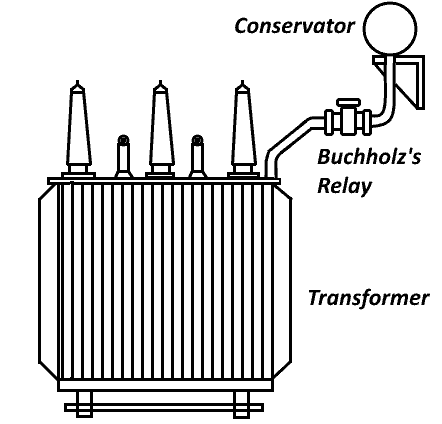Buchholz’s Relay System
The Buchholz's system is used with oil immersed transformers. It consists of a gas operated relay. Whenever short circuiting occurs in the tank of a transformer, the winding temperature increases and the oil round the windings vaporizes. The insulation of the oil becomes weak and as a result gas is produced. This gas operates a relay which further opens the transformers circuit.
This type of relay is a hydraulic relay. A vessel which contains oil. Inside the vessel there are two floats b1 and b2. When fault occurs and gas produces, this gas reaches conservator through pipes. During this processes gas collides with the upper portion of relay chamber and oil vibrates and float b1 goes down. The float b1 closes a mercury contact C1 and an alarm starts ringing. If the rate of gas flow is very high then float b2 also operate and closes the contact C2 and then it trips the circuit. And the circuit become completely upon. The operation of this relay requires a temperature greater than 150°C. Therefore, sudden overload cannot compel the relay to operate.
Conservator
This is a small tank situated on the top of the main tank of transformer figure. This tank is cylindrical in shape. Main tank and conservator are connected with pipes. The conservator performs the following functions
- Provides space to the Oil when the oil starts expansion due to heating. And supply again oil to the main tank when the oil becomes cool
- It decreases the oxidation process by supplying surface area to the oil.
- Oxidized oil is limited to the conservator only.
There is a glass pipe connected to the conservator on one side. This glass pipe contains oil. It shows the cooled oil level.

Name Plate Rating of Transformers
Transformers name plate data include voltage rating, kVA rating, frequency, number of phases, temperature rise, cooling calss, percent impedance and name of manufacturer etc. The kilovolt-ampere (kVA) rating and voltage ratings of a transformer are marked on its name plate. For example typical transformers are marked on its name plate. For example a typical transformer may carry the following information on the name plate. 10kVA, 1100/110 Volts. What are the meanings of these ratings? The voltage rating indicates that the transformer has two windings, one rated for 1100 voltas and the other for 110 voltas. These voltages are proportional to their respective numbers of turns and volts. These voltages are proportional to their respective numbers of turns and therefore, the voltage ration also represents the turn ratio (K = 1100/110 = 10).
The 10kVA rating means that each winding is designed for 10kVA. Therefore, the current rating for the high voltage winding is 10 x 103/110 90.9A.
Generally the name plate of a transformer contains the follwoing information.
| S.No. | Description of data | Data |
|---|---|---|
| 1 | Kind of Transformer | Power Transformer |
| 2 | Relevant standard, year. | |
| 3 | Manufacturer's Name | |
| 4 | Manufacturer's Serial Number | |
| 5 | Year of Manufacture | 2021 |
| 6 | No. of Phases | 3 |
| 7 | Rated Power | 3000 kVA |
| 8 | Rated frequency | 50 Hz |
| 9 | Rated voltage | HV 30 KV |
| 10 | Rated Current | LV 10 KV |
| 11 | Vector Group Symbol | |
| 12 | %age Impedance Voltage | |
| 13 | %age Reactance Voltage | |
| 14 | Type of Cooling | |
| 15 | Total Weight | kg |
| 16 | Quantity of Coil | |
| 17 | Detail about Tap Changer | |
| 18 | Power frequency with stand volatge | |
| 19 | Lightening impulse with stand voltage | |
| 20 | Connection diagram | |
| 21 | Detail about tapings | |
| 22 | Cooling Class |
